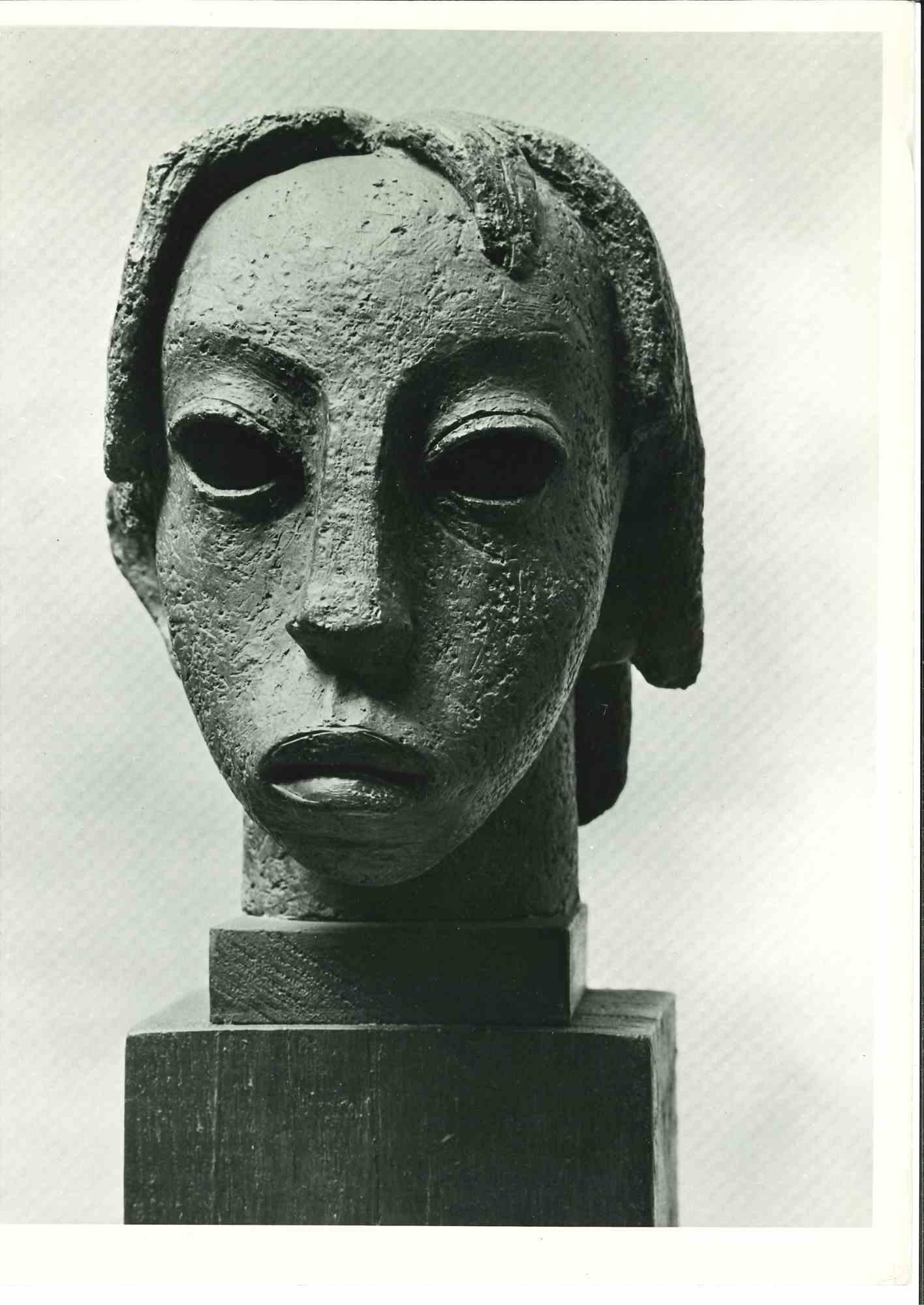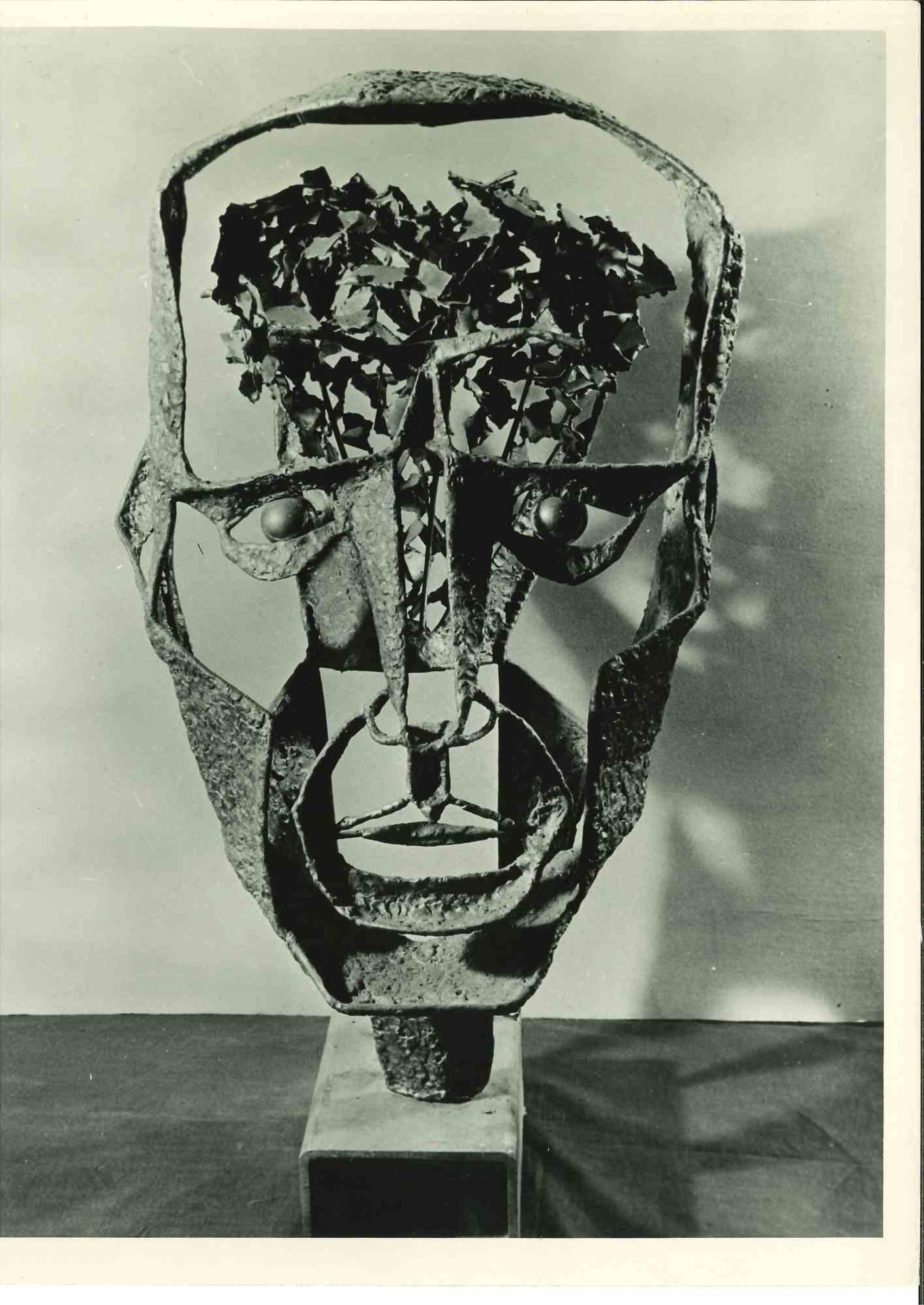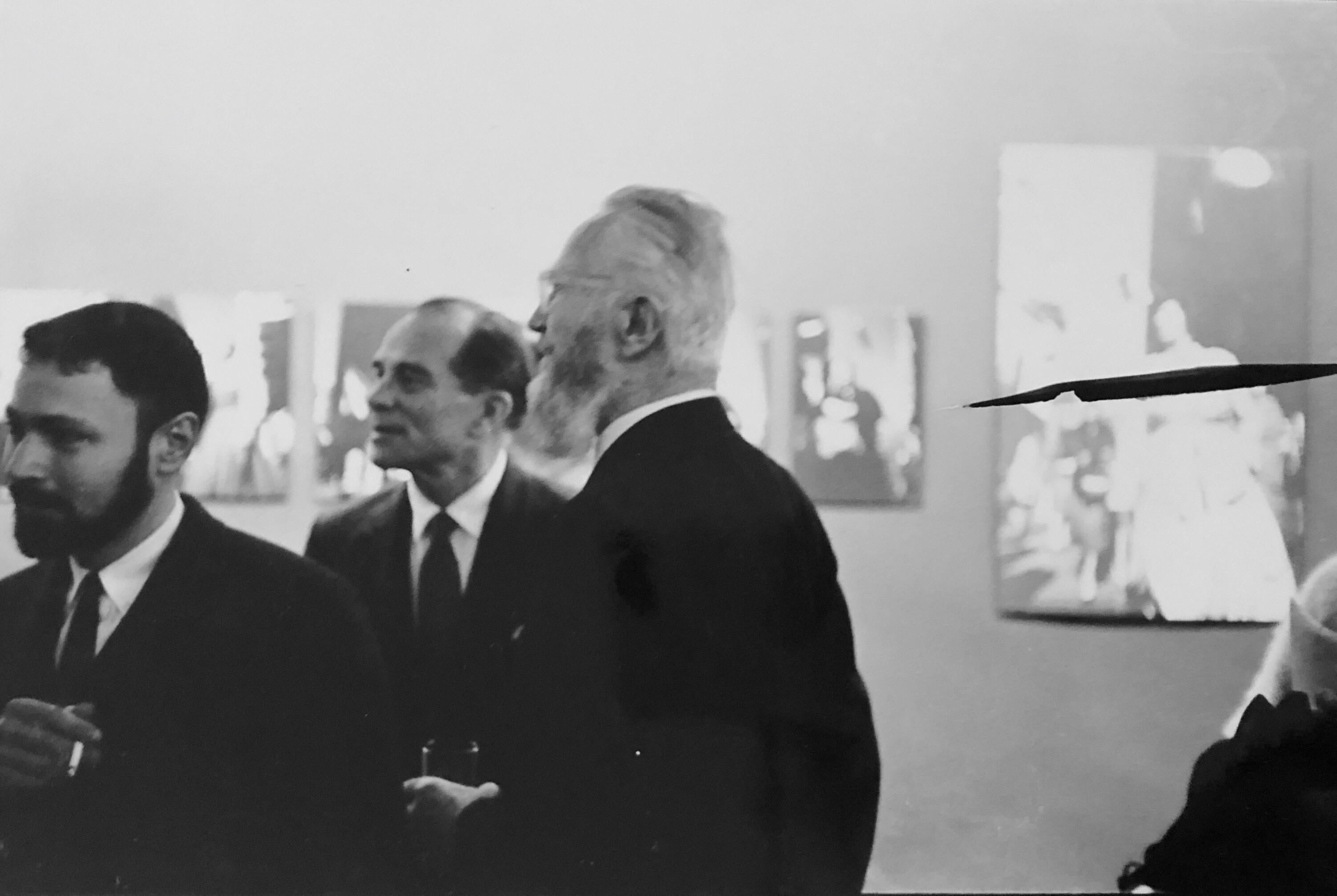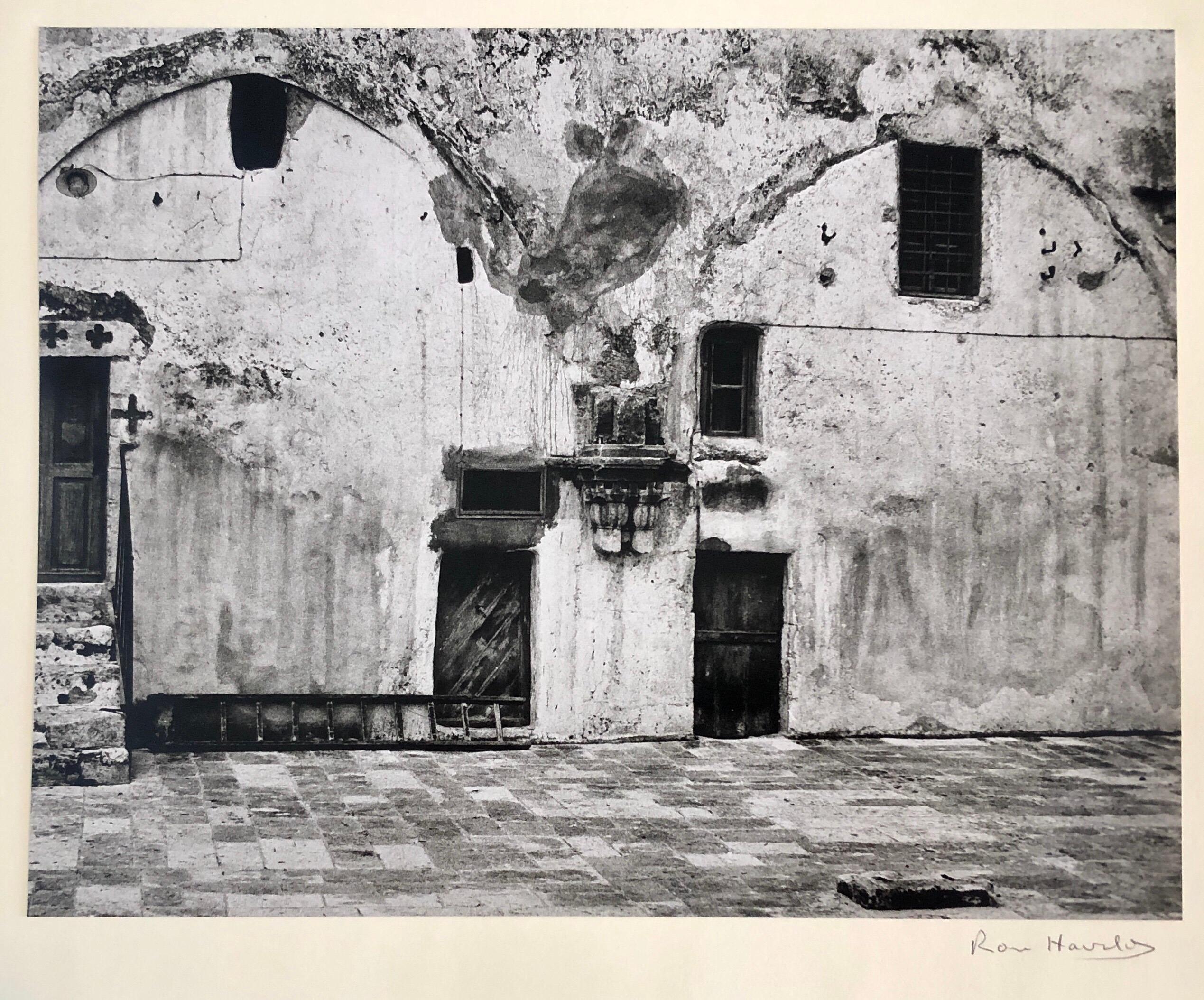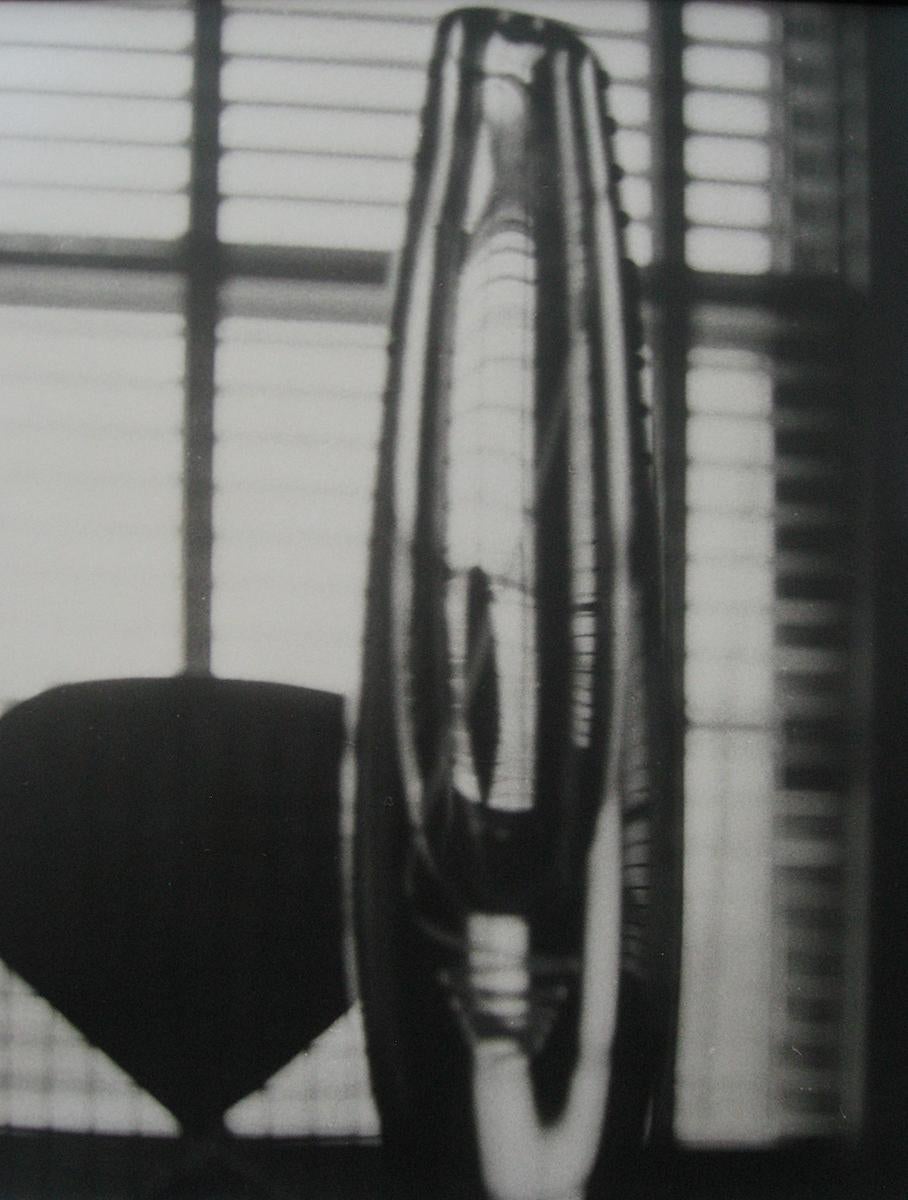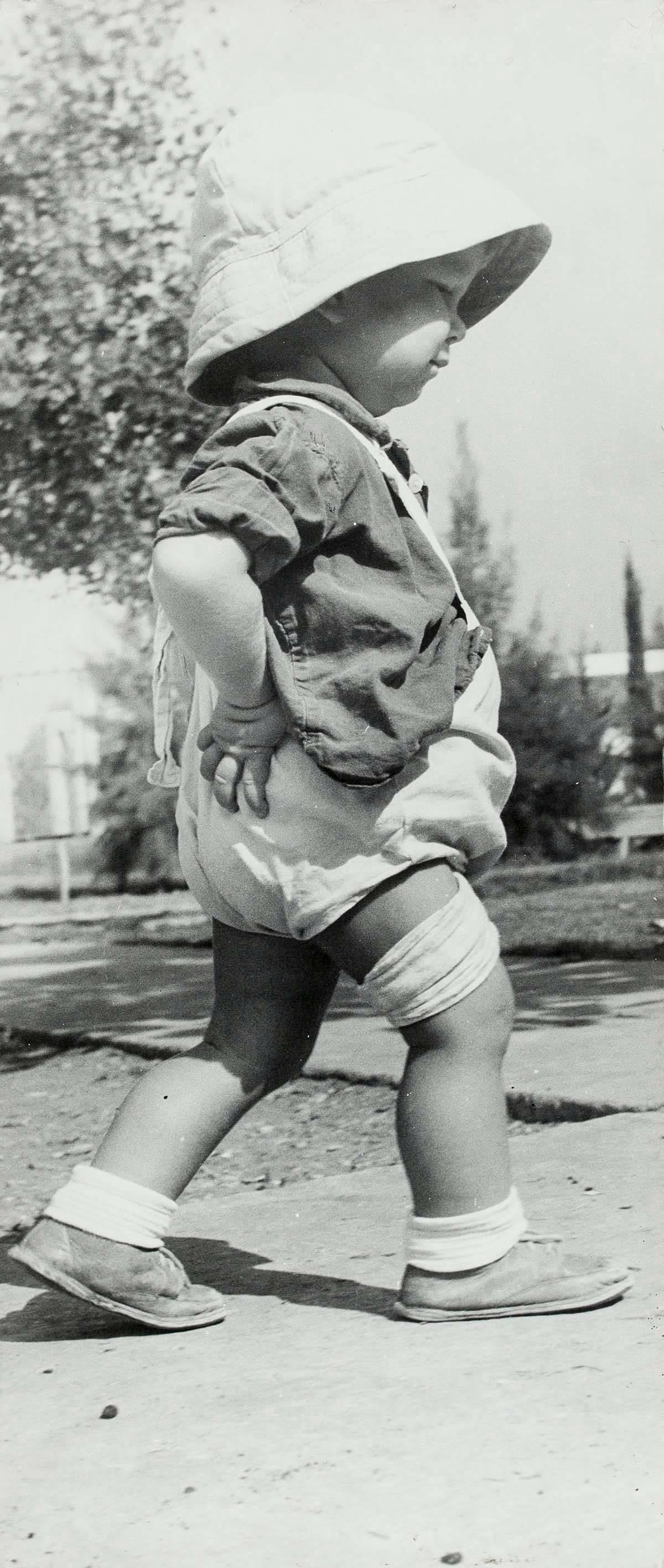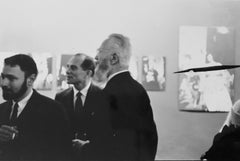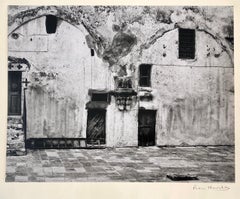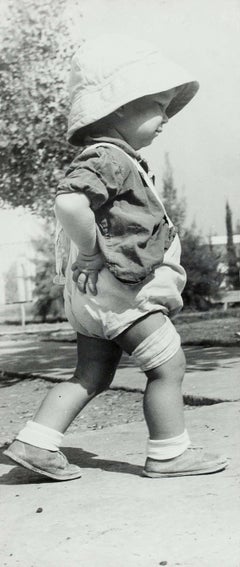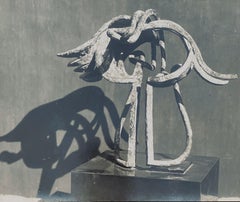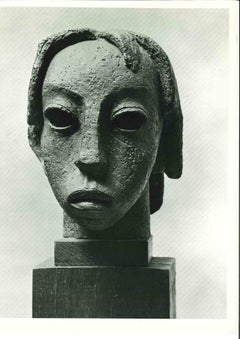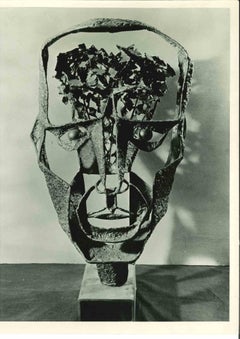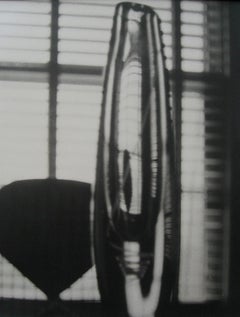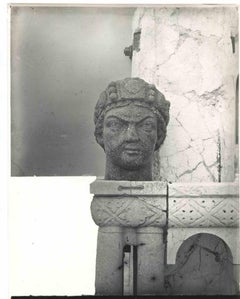Items Similar to Vintage Silver Gelatin Print Photo Israel Museum Sculpture Jerusalem Photograph
Want more images or videos?
Request additional images or videos from the seller
1 of 13
Susan Hacker Vintage Silver Gelatin Print Photo Israel Museum Sculpture Jerusalem Photograph1983
1983
$1,200
£910.53
€1,041.11
CA$1,676.07
A$1,863.57
CHF 973.05
MX$22,684.15
NOK 12,415.72
SEK 11,632.93
DKK 7,770.01
Shipping
Retrieving quote...The 1stDibs Promise:
Authenticity Guarantee,
Money-Back Guarantee,
24-Hour Cancellation
About the Item
Susan Hacker -Israel Museum, Sculpture Garden, Jerusalem, Israel, 1979
Silver Gelatin black/white photograph, printed in 1983, hand signed, titled (Jerusalem) and noted.
There is no edition size stated
Location (Jerusalem), shoot date (1979) and photo print date (1983) and signature in pencil on the bottom back of the photograph. This is of the sculpture Woman skipping rope by Luciano Minguzzi located in the Isamu Noguchi designed sculpture garden at the Israel Museum
Image size: 22 x 33 cm
Paper size: 28 x 35.5 cm
Susan Hacker (1949) is an American photographer and author.
She developed and expanded the photography department at Webster University in St. Louis. Her work is in the possession of at least 25 major museums and libraries around the world. There are also many books and publications about her. Has always experimented with many photographic techniques. Hacker is recognized as an innovator of the modern photography art.
Susan Hacker Stang (born Susan Hacker, October 19, 1949) is an American photographer, author, and educator. Stang served on the faculty of communications at Webster University in St. Louis from 1974 through 2015 and now holds the title Professor Emeritus. She helped found and build the respected photography program there, heading it for most of her tenure at the university. Her work has been collected by more than 25 major museums and libraries around the world and appears in half a dozen books and numerous magazines.
Much of her photography involves the innovative use of alternative cameras, formats, techniques, and media, as evidenced by her two books Encountering Florence (featuring subtly surreal black and white prints of the Italian city using 8 x 10 Polaroid emulsion transfers) and Kodachrome – End of the Run: Photographs from the Final Batches (which chronicles a six-month university photography project in which students and staff would shoot more than 100 roles of rare Kodachrome film for processing on the last day of operations by the world's last remaining Kodachrome processing lab.) In 2016, she published a book of photographs, reAPPEARANCES, which is a sequence of fifty-two photographs made with a digital toy camera (the JOCO VX5). The volume purports to take the viewer on a visual journey through the uncanny coherence of the look of the world, according to Stang's introductory essay.
Stang majored in photography at the Rhode Island School of Design, where she earned both a BFA (1971) and MFA (1974), and studied under photographers Harry Callahan and Aaron Siskind.
In 1971 she moved to London where she worked as a photographer for the British fashion magazine NOVA (published 1965–1975). She joined the faculty of Webster University in St. Louis in 1974, where she helped found and build the photographic studies program in the School of Communications. In Jerusalem in 1979 she was Artist-In-Residence at the Bezalel Academy of Arts and Design. In recent years, in addition to her work as head of the Webster University photography program and professor of communications, she has taught summer photography workshops in Florence, Italy, both at the Santa Reparata International School of Art (SRISA) and The Darkroom. She taught at Webster for 41 years and earned the Kemper Award for Excellence in Teaching.
Stang's photography characteristically employs alternative cameras (such as the Olympus Pen-FT half-frame camera, the Kodak Brownie, and the Holga), or alternative formats (such as Polaroid emulsion transfers) and techniques. Her book of Polaroid emulsion transfers, Encountering Florence was published simultaneously in the U.S. and in Italy (under the title Firenze un Incontro) in 2007. Stang's use of the emulsion transfer process involves transferring the fragile, fabric-like emulsion layer of the photograph (bearing the image) to another surface, subtly transforming the original image in a variety of ways. The results were described in Photo Review as giving Stang's portraits of Florence's buildings, streets, statuary, and gardens "a delicate, draping quality ... reminiscent of the fabrics draped on the ancient statues within the images". An Italian reviewer observed that the photographic process presents "a city not previously seen and perhaps a little disquieting". The book's bi-lingual text in English and Italian was selected and edited by Stang and by Andrea Burzi and Susanna Sarti, both of Florence, to present accompanying word-portraits from authors in their own encounters with the city. A portfolio of Stang's work for the book is held by the Rare Books Collection of the Biblioteca Nazionale Centrale Firenze.
In 2010–11, Stang led the Webster University photography program in a six-month-long focus on the color reproduction qualities of Kodachrome film (long revered by professional and amateur photographer for its true, lush color rendition qualities) to mark the permanent discontinuing of the film's production by Kodak. The project ultimately turned into a book documenting the final demise of the medium, and the last day of Kodachrome production anywhere in the world (at Dwayne's Photo in Parsons, Kansas, on January 18, 2011). The last days of processing were covered by The New York Times, National Geographic, and network television.
Edited by Stang and fellow photographer Bill Barrett, Kodachrome: End of the Run presents a selection of four-score Kodachrome images shot on more than 100 roles of the film by Webster University students, faculty, and staff over a five-month period and processed by Dwayne's in the final hours as the last processing chemicals ran out. The book includes essays by Stang, Time Magazine worldwide pictures editor Arnold Drapkin, and Dwayne's Photo vice president Grant Steinle.
Stang's work is also found in museums and library collections, including the Bibliothèque Nationale, Paris; the High Museum of Art, Atlanta; the California Museum of Photography, Riverside; the Saint Louis Art Museum, the Southeast Museum of Photography; and the Portland Museum of Art.
Her photographs have been published in a number of books and magazines, including Exploring Color Photography, second edition (1993), Jerusalem As She Is (1991), The Visionary Pinhole (1985), Between Twelve and Twenty (1982), Creative Camera International Yearbook (1977), and Women See Woman (1976), Hatzilu Magazine, Israel (July 1979), the British Journal of Photography, London (April 1972), and NOVA (1971–1972 issues).
- Creator:Susan Hacker
- Creation Year:1983
- Dimensions:Height: 11 in (27.94 cm)Width: 14 in (35.56 cm)
- Medium:
- Movement & Style:
- Period:
- Condition:good. never framed. Edges are slightly wavy. Please see photos.
- Gallery Location:Surfside, FL
- Reference Number:1stDibs: LU38214789112
About the Seller
4.9
Platinum Seller
Premium sellers with a 4.7+ rating and 24-hour response times
Established in 1995
1stDibs seller since 2014
1,784 sales on 1stDibs
Typical response time: <1 hour
- ShippingRetrieving quote...Shipping from: Surfside, FL
- Return Policy
Authenticity Guarantee
In the unlikely event there’s an issue with an item’s authenticity, contact us within 1 year for a full refund. DetailsMoney-Back Guarantee
If your item is not as described, is damaged in transit, or does not arrive, contact us within 7 days for a full refund. Details24-Hour Cancellation
You have a 24-hour grace period in which to reconsider your purchase, with no questions asked.Vetted Professional Sellers
Our world-class sellers must adhere to strict standards for service and quality, maintaining the integrity of our listings.Price-Match Guarantee
If you find that a seller listed the same item for a lower price elsewhere, we’ll match it.Trusted Global Delivery
Our best-in-class carrier network provides specialized shipping options worldwide, including custom delivery.More From This Seller
View AllVintage Silver Gelatin Signed Photograph Edward Steichen, MoMA Photo
By Fred McDarrah
Located in Surfside, FL
Edward Steichen, John Durniak, Monroe Wheeler and Edward D. Museum of modern art on Feb 10, 1962
Photographer Fred McDarrah
Over a 50-year span, McDarrah documented the rise of the Beat Generation, the city’s postmodern art movement, its off-off-Broadway actors, troubadours, politicians, agitators and social protests.
Fred captured Jack Kerouac frolicking with women at a New Year’s bash in 1958, Andy Warhol adjusting a movie-camera lens in his silver-covered factory, and Bob Dylan offering a salute of recognition outside Sheridan Square near the Voice’s old office.
Not just a social chronicler, McDarrah was a great photo-journalist.
For years, McDarrah was the Voice's only photographer and, for decades, he ran the Voice’s photo department, where he helped train dozens of young photographers, including James Hamilton, Sylvia Plachy, Robin Holland and Marc Asnin. His mailbox was simply marked "McPhoto."
An exhibit of McDarrah’s photos of artists presented by the Steven Kasher Gallery in Chelsea was hailed by The New York Times as “a visual encyclopedia of the era’s cultural scene.”
artists in their studios, (Alice Neel, Philip Guston, Stuart Davis, Robert Smithson, Jasper Johns, Franz Kline), actors (Dustin Hoffman, Robert De Niro on the set of “Taxi Driver”), musicians (Janis Joplin, Alice Cooper, Bob Dylan) and documentary images of early happenings and performances (Yayoi Kusama, Charlotte Moorman, Al Hansen, Jim Dine, Nam June Paik). The many images of Andy Warhol include the well-known one with his Brillo boxes at the Stable Gallery in 1964. Woody Allen, Diane Arbus, W. H. Auden, Francis Bacon, Joan Baez, Louise Bourgeois, David Bowie, Jimmy Breslin, William Burroughs, John Cage, Leo Castelli, Christo, Leonard Cohen, Merce Cunningham, William de Kooning, Jim Dine, Mark di Suvero, Marcel Duchamp, Bob Dylan, Federico Fellini, Allen Ginsberg, Robert Indiana, Mick Jagger, Jasper Johns, Kusama, John Lennon, Sol Lewitt, Roy Lichtenstein, Nam June Paik, Elvis Presley, Claes Oldenburg, Yoko Ono, Robert Rauschenberg, Lou Reed, James Rosenquist, Mark Rothko, Ed Ruscha, Robert Smithson, Susan Sontag, Andy Warhol, and others. McDarrah’s prints have been collected in depth by the J. Paul Getty Museum and the National Portrait Gallery, Washington. His work is in numerous public and private collections.
Edward Jean Steichen (March 27, 1879 – March 25, 1973) was a Luxembourgish American photographer, painter, and art gallery and museum curator. Steichen's were the photographs that most frequently appeared in Alfred Stieglitz's groundbreaking magazine Camera Work during its publication from 1903 to 1917. Together Stieglitz and Steichen opened the Little Galleries of the Photo-Secession, which eventually became known as '291', after its address.
Steichen laid claim to his photos of gowns for the magazine Art et Décoration in 1911 being the first modern fashion photographs ever published. From 1923 to 1938, Steichen was a photographer for the Condé Nast magazines Vogue and Vanity Fair while also working for many advertising agencies including J. Walter Thompson. During these years, Steichen was regarded as the best known and highest paid photographer in the world. In 1944, he directed the war documentary The Fighting Lady, which won the 1945 Academy Award for Best Documentary.
From 1947 to 1961, Steichen served as Director of the Department of Photography at New York's Museum of Modern Art. While at MoMA, he curated and assembled exhibits including The Family of Man, which was seen by nine million people. In 1904, Steichen began experimenting with color photography. He was one of the earliest in the United States to use the Autochrome Lumière process. In 1905, Stieglitz and Steichen created the Little Galleries of the Photo-Secession, which eventually became known as 291 after its address. It presented some of the first American exhibitions of Henri Matisse, Auguste Rodin, Paul Cézanne, Pablo Picasso, and Constantin Brâncuși.
He worked with Robert Frank even before his The Americans was published, exhibited the early work of Harry Callahan and Aaron Siskind, and purchased two Rauschenberg prints...
Category
1960s American Modern Black and White Photography
Materials
Silver Gelatin
Vintage Silver Gelatin Photograph Wallscape, Jerusalem Architectural Photo
Located in Surfside, FL
Jerusalem Architecture Photo
This is for one Photograph from the portfolio entitled "Jerusalem: City of Mankind," The mounting is 14 X 17 inches. ...
Category
1970s Modern Landscape Photography
Materials
Photographic Paper, Silver Gelatin
Large Mounted Vintage Silver Gelatin Israeli Kibbutz Photograph
By Peter Merom
Located in Surfside, FL
A little boy who just received a penicillin shot. signed on back with studio stamp. along with an old description label.
this is mounted to wood and not framed or behind glass. it has some wear and surface soiling but it is a lovely charming piece and shows well.
Peter Merom ( Hebrew : פטר מירום, born 1919 ) is an Israeli photographer born in Germany. He specializes in landscape photography and landscape detail.
He was born in Lower Silesia and in 1934 emigrated from Germany to the British Mandate Palestine , where he settled four years later in the kibbutz Chulata . In 1935 he bought the first compact camera and began to amateur photography. After working as a fisherman in the kibbutz, he began to photograph Lake Chulus and then recorded his desiccation in 1951 to 1958. He gained his first artistic education as a self-taught specialist literature, international magazines and photographic anniversaries. In 1957 he studied photography in France . In Paris, he worked in a printing works where many photographers, such as Henri Cartier-Bresson and other photographers, printed their photographs. At that time, he made a series of photos of The Dying Lake , which he presented at the Telaviv Museum of Art . In 1974 he stopped working as a photographer and began to produce and sell photographs from his archive printed on plywood.
In 2000 he received an award from the Israeli Museum for a lifetime work in the field of photography. In 2010, he received the Israel prize for a photograph taken every five years.
Education
1957 Photography...
Category
20th Century Black and White Photography
Materials
Plywood, Silver Gelatin
Vintage Silver Gelatin Photograph Jacques Lipchitz Sculpture Photo Signed
By Marc Vaux
Located in Surfside, FL
Marc Vaux, a figure of Montparnasse, produced a trove of photographs which are currently held in the collection of the Centre Pompidou in Paris, France. Marc Vaux was committed equally to supporting artists, notably by creating the Foyer des Artistes (1946-70) and, in 1951, the first Musée du Montparnasse at 10, rue de l’Arrivée.
Marc Vaux was born on February 19, 1895 in Crulai, Normandy Thanks to the color merchant from whom he bought his plates and his photographic equipment, he met the sculptor Charles Desvergnes winner of Prix the Rome and author of various memorials who was looking for someone to photographs his works. Two of Marc Vaux’s first clients were his neighbors of 21 Avenue du Maine- Marie Vassilieff and Maria Blanchard...
Category
1930s Modern Abstract Photography
Materials
Photographic Paper, Silver Gelatin
Vintage Silver Gelatin Print Photograph Marcus Leatherdale Shrouded Figure Photo
Located in Surfside, FL
Marcus Leatherdale (1952 - 2022)
Silver gelatin print with copper leaf mount
1987
Titled: High Priest. From the Demigod series.
Hand signed and dated and bears artist studio stamp verso.
Provenance: Greathouse Gallery (with label & information verso)
Edition: 1 of 10.
Dimensions mage measures 12" x 5", total measurements are 24" x 13"
Marcus Leatherdale was a Canadian portrait photographer.
Marcus Andrew Leatherdale was born on 18 September 1952, in Montreal, Canada, to Jack Leatherdale, a veterinarian, and Grace Leatherdale, a homemaker. He attended the San Francisco Art Institute.
Leatherdale arrived in New York City in 1978, where he attended the School of Visual Arts. started his career in New York City during the early eighties, setting up a studio on Grand Street.
Leatherdale first served as Robert Mapplethorpe office manager for a while and was photographed in the nude by the master, grabbing a rope with his right hand and holding a rabbit in his left.
Thereafter he worked as an assistant curator to Sam Wagstaff. He soon became a darling of the then vibrant club scene and the fashionable media: Interview, Details, The New Yorker, Vanity Fair, and Elle Decor presented his work. Later on he was featured in artsy publications as Artforum, Art News, and Art in America. Leatherdale was the Cecil Beaton of downtown New York,
He photographed a not-yet-famous club kid named Madonna in her ripped jeans and his denim vest. The performance artist Leigh Bowery was majestic in a tinseled mask, a corset and a merkin. Andy Warhol was a Hamlet in a black turtleneck. Susanne Bartsch, the nightlife impressaria, was a towering presence in red leather. He documented the New York City lifestyle, the extraordinary people of Danceteria and Club 57 where he staged his first exhibits in 1980. Leatherdale was an acute observer of the New York City of the nineteen eighties. His models were the unknown but exceptional ones – like Larissa, Claudia Summers or Ruby Zebra – or well known artists – like Madonna, Keith Haring, Andy Warhol, Winston Tong and Divine, Trisha Brown, Lisa Lyon, Andrée Putman, Kathy Acker and Sydney Biddle Barrows, otherwise known as the Mayflower Madam, Jodie Foster, and fellow photographer John Dugdale. He Married Claudia Summers, theirs was not a traditional marriage, but they were best friends, and he was Canadian, so it made life easier if they wed. His boyfriend for a time was Robert Mapplethorpe, whose photography studio Mr. Leatherdale also managed. He and Mapplethorpe were a striking pair, dressed like twins in leather and denim, their faces as if painted by Caravaggio, and they often photographed each other.
Jean-Michel Basquiat was often hanging out there, playing his bongo drums; so were friends like Cookie Mueller, the doomed, gimlet-eyed author and Details magazine contributor who was for a time Mapplethorpe’s and Ms. Summers’ drug dealer, and Kathy Acker, the performance artist and novelist. For quite a while Leatherdale remained in Mapplethorpe's shadow, but was soon discovered as a creative force in his own right by Christian Michelides, the founder of Molotov Art Gallery in Vienna. Leatherdale flew to Vienna, presented his work there and was acclaimed by public and press.
This international recognition paved his way to museums and permanent collections such as the Rheinisches Landesmuseum Bonn, the Art Institute of Chicago, the Australian National Gallery in Canberra, the London Museum in London, Ontario, and Austria's Albertina. He was included in the MoMA exhibit New York/New Wave along with Kenny Scharf, William Burroughs, John Crash Matos, Larry Clark, Nan Goldin, Lawrence Weiner and Stephen Sprouse. Above all, his arresting portraits of New York City celebrities in the series Hidden Identities aroused long-lasting interest amongst curators and collectors.
In 1993, Leatherdale began spending half of each year in India's holy city of Banaras. Based in an ancient house in the centre of the old city, he began photographing the diverse and remarkable people there, from the holy men to celebrities, from royalty to tribals, carefully negotiating his way among some of India's most elusive figures to make his portraits. From the outset, his intention was to pay homage to the timeless spirit of India through a highly specific portrayal of its individuals. His pictures include princesses and boatmen, movie stars and circus performers, and street beggars and bishops, mothers and children in traditional garb. Leatherdale explored how essentially unaffected much of the country was by the passage of time; and it has been remarked upon that this approach is distinctly post-colonial. In 1999, Leatherdale relocated to Chotanagpur (Jharkhand) where he focusing upon the Adivasis. Later Serra da Estrela in the mountains of central Portugal became his second home base.
Leatherdale's matte printing techniques, which adapt nineteenth-century processes and employ half black, half sepia colorations, reinforce the timelessness of his subjects. Tones and matte surfaces effectively differentiate his portraits from the easy slickness of fashion photography.
In 2019, Mr. Leatherdale compiled his work from 80s in a book entitled “Out of the Shadows”, written with Claudia Summers.
During his time in New York City, he dated Robert Mapplethorpe, whose photography studio Leatherdale managed. His partner of two decades, Jorge Serio, died in July 2021
Major exhibitions
1980 Urban Women, Club 57, NYC
1980 Danceteria, NYC
1981 Stilvende, NYC
1982 The Clock Tower, PS1, NYC
1982 544 Natoma Gallery, San Francisco
1982 Eiko And Koma, Stilvende, NYC
1983 Form And Function Gallery, Atlanta
1983 Galerie in der GGK Wien, Vienna, Austria
1983 The Ring, Vienna (organized by Molotov)
1983 London Regional Art Gallery, London, Ontario, Canada
1984 Performance, Greathouse Gallery, NYC
1984 Social Segments, Grey Art Gallery, NYU
1984 Rheinisches Landesmuseum, Bonn
1985 Ritual, Greathouse Gallery, NYC
1985 Artinzer, Munich
1985 Leatherdale/Noguchi, Gallery 291, Atlanta
1985 Paul Cava Gallery, Philadelphia
1986 Poison Ivy, Greathouse Gallery, NYC
1986 Wessel O’Connor Gallery, Rome
1986 Hidden Identities, Michael Todd Gallery, Palladium, NYC
1987 Demigods, Greathouse Gallery, NYC
1987 Collier Gallery, Scottsdale, Arizona
1987 Tunnel Gallery, NYC
1988 Claus Runkel Fine Art Ltd., London, UK
1988 Madison Art Center, Madison
1989 Wessel-O’Connor Gallery, NYC
1989 Summer Night Festival, Onikoube, Sendai
1990 Bent Sikkema Fine Art, NYC
1990 Fahey-Klein Gallery, Los Angeles
1990 Faye Gold Gallery, Atlanta
1990 Mayan Theatre, Los Angeles
1991 Runkel Hue-Williams Gallery, London
1991 Galerie Michael Neumann, Düsseldorf
1991 Arthur Rogers Gallery, New Orleans
1992 Arthur Rogers, NYC
1992 Galerie Del Conte, Milwaukee
1993 Galerie Bardamu, NYC
1996 Fayf Gold Gallery, Atlanta
1996, 1997, 1998, 1999 Bridgewater/Lustberg, NYC
1998 Rai Krishna Das...
Category
1980s 85 New Wave Black and White Photography
Materials
Silver Gelatin
Vintage Silver Gelatin Photo of Ibram Lassaw Modernist Sculpture (Photograph)
Located in Surfside, FL
Space Densities
This is for the original vintage photograph. I believe the inscription is in the hand of Ibram Lassaw some also bear the photographers stamp.
Lassaw was born in Alexandria, Egypt, of Russian Jewish émigré parents, he went to the U.S. in 1921. His family settled in Brooklyn, New York. He became a US citizen in 1928. He first studied sculpture in 1926 at the Clay Club and later at the Beaux-Arts Institute of Design in New York. He made abstract paintings and drawings influenced by Kandinsky, Sophie Tauber Arp...
Category
1960s Abstract Expressionist Abstract Photography
Materials
Silver Gelatin
You May Also Like
Three Women Sculpture - American Vintage Photograph - Mid 20th Century
Located in Roma, IT
Three Women Sculpture- American Vintage Photograph is an original black and white photograph realized in the U.S in the mid-20th Century in a series of American life in the 20th Cent...
Category
Mid-20th Century Modern Figurative Photography
Materials
Photographic Paper
Three Women Sculpture - American Vintage Photograph - Mid 20th Century
Located in Roma, IT
Three Women Sculpture - American Vintage Photograph is an original black and white photograph realized in the U.S in the mid-20th Century in a series of American life in the mid-20th...
Category
Mid-20th Century Modern Figurative Photography
Materials
Photographic Paper
Illusion by Ida Lansky, ca. 1950's, Vintage Silver Gelatin Print, Photography
By Ida Lansky
Located in Denton, TX
Illusion by Ida Lansky depicts a glass vase in front of a window with blinds. The background is distorted through the glass, abstracting the image by emphasizing the varying tones and shapes.
Illusion by Ida Lansky is listed as a 9.5 x 7.5 inch vintage gelatin silver print. This photograph is signed and titled in pencil on mount margin by artist.
Ida G. Lansky was born in 1910 in Toronto, Canada. She pursued many careers in her lifetime including Nursing, Art, and Library Science. In 1928 she moved to New York City and later attended New York University, The Jewish Hospital in Brooklyn, NY and Cornell University. In 1942 she received a B.S. in Public Health Nursing.
Ida Lansky moved to Hawaii in 1945 and married Irving Lansky. She then moved to Nor- man, Oklahoma and then to Denton, Texas where she studied art and was mother to two children, Ellen and Michele.
From 1954 - 1959 she was in the Visual Art studies program at Texas Women’s University in Denton with an emphasis on photography. She studied under Carlotta Corpron...
Category
1950s Modern Black and White Photography
Materials
Silver Gelatin
Sculpture - Vintage B/W photo - Early 20th Century
Located in Roma, IT
The sculpture is a b/w photographic print on Cardboard.
The artwork represents a sculpture.
Category
1950s Modern Black and White Photography
Materials
Photographic Paper
Woman Sculpture - American Vintage Photograph - Mid 20th Century
Located in Roma, IT
Woman Sculpture - American Vintage Photograph is an original black and white photograph realized in the U.S in the mid-20th Century in a series of American life in the 20th Century.
...
Category
Mid-20th Century Modern Figurative Photography
Materials
Photographic Paper
Untitled 20251 - lith silver gelatin print
By John Casado
Located in Burlingame, CA
John Casado - Untitled 20251, figurative black and white male nude.
2001 - Unique lith silver gelatin photographic print.
image = 22 3/4 x...
Category
21st Century and Contemporary Contemporary Nude Photography
Materials
Silver Gelatin
More Ways To Browse
White Woman Sculpture
Israeli Women
Ancient Israel
Kodak Photo Vintage
Vintage Television Cameras
Vintage Fashion Two Twenty
Noguchi Signed
Woman Statue Italian
Bezalel Silver
Isamu Noguchi Print
Reproduction Vintage Toys
Vintage British Toys
Vintage Kodachrome
Rare Kodak Cameras
Sheridan Silver
Sid Vicious
Vintage Bette Midler
Vintage Tattoo Photography
